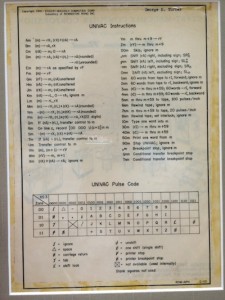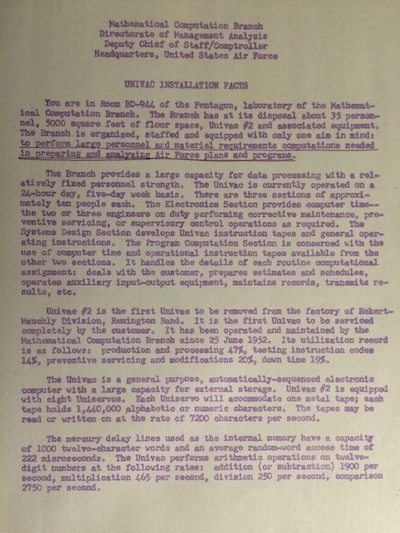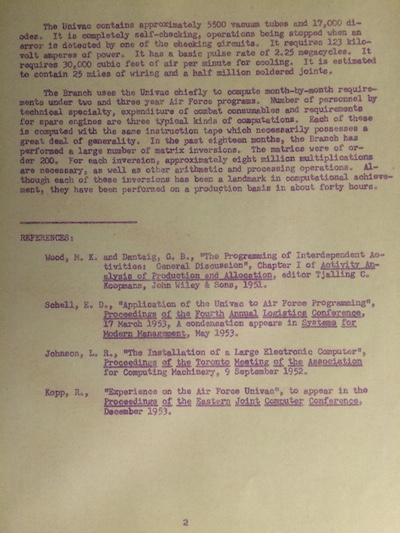My Grandfather and the UNIVAC
by Scott Schneider
Pictured below is my grandfather’s cheat sheet for the UNIVAC I. He typed his name, George Eugene Turner, in the upper right. The copyright, in the upper left, reads 1951. (Click for a larger image.)

The ghost image is the reverse side of the sheet, which is the cover to the manual. The UNIVAC I was the first digital, electronic, general purpose computer built it one location, and moved to another location for operation. (The first digital, electronic, general purpose computer was the ENIAC. For an excellent history of it, read ENIAC: The Triumphs and Tragedies of the World’s First Computer by Scott McCartney.)
My grandfather was one of the first people to use it—that my grandfather used some of the first computers has been a part of family lore as long as I can remember. What was uncertain to me, however, was which UNIVAC he worked with. The first one? It appears so.
In the the retrospective Coming to Grips with the UNIVAC by Lyle Johnson, he writes:
Once the Census Univac had passed its tests, Remington Rand management naturally expected prompt acceptance of the second system. The factory raced to meet its target date of mid-November. Schell and I were observers when testing started on 13 November. The CPU, as well as our two Unitypers (offline keyboard-to-tape units) and two Uniprinters (offline tape-fed typewriter printers), were soon deemed acceptable. But our Uniservos—the eight magnetic tape devices connected to the CPU, were not. We returned for testing on 27 November and stayed over, again to learn that NBS was holding up delivery.
Meanwhile, Schell made a deal with Census for use of its computer over the New Year weekend. Three of our programmers—Natalie Coplan, Harold Fisher, and George Turner agreed to use the time for program debugging. Schell and I went along to reassure Census management, provide moral support, and gain familiarity with the Univac. We were there 29-31 December 1951 and 1 January 1952. This was my opportunity to examine devices, mount reels of metal tape, decode data indicated by the many little neon lamps, watch read/write error- recovery processes, and ask questions of Eckert-Mauchly engineers during maintenance. All told, it was an exciting weekend.
The first UNIVAC I went to Census, but it was not actually the first one shipped. The first shipped UNIVAC I went to the Air Force. However, it appears that my grandfather also programmed on the Air Force’s UNIVAC. Picture below is a document we have from the Mathematical Computation Branch of the United States Air Force. (Click for a larger image.)

The document says:
You are in Room BD-944 of the Pentagon, laboratory of the Mathematical Computation Branch. The Branch has at its disposal about 35 personnel, 5000 square feet of floor space, Univac #2 and associated equipment. The Branch is organized, staffed and equipped with only one aim in mind: to perform large personnel and material requirements computations needed in preparing and analyzing Air Force plans and programs.
The Branch provides a large capacity for data processing with a relatively fixed personnel strength. The Univac is currently operated on a 24-hour, five-day week basis. There are three sections of approximately ten people each. The Electronics Section provides computer time—the two or three engineers on duty performing corrective maintenance, preventive servicing, or supervisory control operations as required. The Systems Design Section develops Univac instruction tapes and general operating instructions. The Program Computation Section is concerned with the use of computer time and operational instruction tapes available from the other two sections. It handles the details of each routine computational assignment; deals with the customer, prepares estimates and schedules, operates auxiliary input-output equipment, maintains records, transmits results, etc.
Univac #2 is the first Univac to be removed from the factory of Eckert-Mauchly Division, Remington Rand. It is the first Univac to be serviced completely by the customer. It has been operated and maintained by the Mathematical Computation Branch since 25 June 1952. Its utilization record is as follows: production and processing 47%, testing instruction codes 14%, preventative servicing and modifications 20%, down time 19%.
The Univac is a general purpose, automatically-sequenced electronic computer with a large capacity for external storage. Univac #2 is equipped with eight Uniservos. Each Uniservo will accommodate on metal tape; each tape holds 1,440,000 alphabetic or numeric characters. The tapes may be read or written on at the rate of 7200 characters per second.
The mercury delay lines used as the internal memory have a capacity of 1000 twelve-character words and an average random-word access time of 222 microseconds. The Univac performs arithmetic operations on twelve-digit numbers at the following rates: addition (or subtraction) 1900 per second, multiplication 465 per second, division 250 per second, comparison 2750 per second.
The Univac contains approximately 5500 vacuum tubes and 17,000 diodes. It is completely self-checking, operations being stopped when an error is detected by one of the checking circuits. It requires 123 kilovolt amperes of power. It has a basic pulse rate of 2.25 megacycles. It requires 30,000 cubic feet of air per minute for cooling. It is estimated to contain 25 miles of wiring and a half million soldered joints.
The Branch uses the Univac chiefly to compute month-by-month requirements under two and three year Air Force programs. Number of personnel by technical specialty, expenditure of combat consumables and requirements for spare engines are three typical kinds of computations. Each of these is computed with the same instruction tape which necessarily possesses a great deal of generality. In the past eighteen months, the Branch has performed a large number of matrix inversions. The matrices were of order 200. For each inversion, approximately eight million multiplications are necessary, as well as other arithmetic and processing operations. Although each of these inversions has been a landmark in computational achievement, they have been performed on a production basis in about forty hours.
A few observations:
- The document says “Univac #2”, but it means UNIVAC I, #2. The UNIVAC I was not called such until the UNIVAC II.
- The character reading and writing rate (7200 characters per second) is greater than the fastest computation rate (2750 comparisons per second). Depending on the number of characters required to represent a number, input and output for some data could be faster than its processing. This relationship would not hold as computers advanced. In modern systems, processing has outstripped reading and writing to the point that we frequently trade significant processing time for a little less reading and writing. Two examples are compressing data before writing, and sophisticated paging algorithms.
- The relative cost of division to addition is similar to what it is today.
- Even in the beginning, we needed to cool our systems.
- A matrix inversion of 200 elements was considered a “landmark in computational achievement”.
My grandfather is also credited as a UNIVAC I Pioneer, acknowledged in the 1960 Census, and is credited as the Chief Programmer, Survey of Components of Change and Residential Finance for it.
By the modern definition of the word, my grandfather was one of the first programmers.
Thanks to Dan Gackle for reviewing a draft of this essay.
